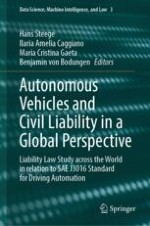2024 | OriginalPaper | Buchkapitel
The Law Applicable to Autonomous Cars Driving in France
verfasst von : Lionel Andreu
Erschienen in: Autonomous Vehicles and Civil Liability in a Global Perspective
Aktivieren Sie unsere intelligente Suche, um passende Fachinhalte oder Patente zu finden.
Wählen Sie Textabschnitte aus um mit Künstlicher Intelligenz passenden Patente zu finden. powered by
Markieren Sie Textabschnitte, um KI-gestützt weitere passende Inhalte zu finden. powered by
